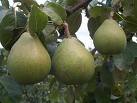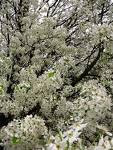 BLACKBERRIES OR BRAMBLES, RUBUS FRUTICOSUS
BLACKBERRIES OR BRAMBLES, RUBUS FRUTICOSUSBlackberries or brambles grow on thorny bushes wild throughout the UK. If you’ve never picked blackberries then you can’t imagine how good they are when you’ve been pricked by the thorns on the bushes because you just had to get at the ripe, plump, juicy blackberry that was almost out of your reach. To go home and make your own pie, tart or crumble and have it with double cream, ice cream or custard is a wonderful experience and one to be recommended. However, these days with all the pollution around, you need to wash them thoroughly before eating unless you have a wood near you which is “far from the madding crowd”. Apart from the thorns, you should be careful not to get the juice on your clothes as it stains badly - wear old ones to go brambling. The fruit, like that of raspberries is made up of small fruitlets, each bearing a seed.

Blackberries are close relations of
raspberries (the same
Rubus name) and are in the
rose family so are related more distantly to
loquats,
quinces,
plums,
peaches,
strawberries, apples and
pears. The brambles flower from May to September and the berries are ripe from August through to November, but are best picked early in the season despite a superstition in some parts of England that they shouldn’t be gathered before St. Michael’s Day which is late in September (29
th). Country folk once believed that when the Devil was cast out of Paradise, he fell into a bramble bush and cursed it. If you ate the fruit before the Saints Day it was cursed. In Ireland it is said that the Devil stamps on the bush and throws his cloak over them so that they are inedible after the 19
th of October, which is when you can see the slimy marks of a parasite which attacks them in the autumn. In fact there are other superstitions surrounding blackberries, such as one in Cornwall in the south-west of England that children could be cured of ruptures and hernias if they were passed through a looped bramble. This is formed when a barren shoot curls away from the plant and then goes back to the ground and roots. In the same county this was also believed to be a cure for warts. To heal scalds and burns 9 blackberry leaves had to be dipped in spring water and then this charm was said three times, “There came three angels out of the East. One brought fire, and two brought frost, in the name of the Father, Son and Holy Ghost.” It was also believed that warts could be cured with the first blackberries of the season, whether these were eaten or the juice was rubbed on the warts I’m not sure. If blackberries flower early, then this is supposed to be a sign of an early harvest.

At one time it was believed that the berries could drive away snakes, and if you dreamed of going through a blackberry thicket, or a place that was covered with brambles, then misfortune would befall. If you were pricked by their thorns in your dream, this would mean that your reputation would be damaged, and if you bled you would lose money. If you got through the bramble patch unscathed though, you would triumph in your current endeavours.
Blackberries are black because of the anthocyanins present in them and these are also present in the black or Virginian raspberry,
blackcurrants and
wimberries. These have powerful antioxidant properties and help, along with those of
vitamins C and E and the polyphenols present in blackberries, to make the berry one of the top fruits in the antioxidant stakes. This means that they can help prevent some cancers, including colon cancer, and the stave off the risk of strokes and heart disease. As for
minerals, they contain calcium, manganese, iron, phosphorous and magnesium, potassium, zinc, copper and traces of selenium. Some of the
B-complex vitamins are also present as is vitamins K.

In traditional medicine blackberry leaves and roots have been used for their astringency to help in diarrhea and dysentery, the dried fruit, reduced to a powder is also useful for these complaints. Make a tisane with 1 oz of dried leaves crumbled and pour a pint of boiling water over them. Leave this to infuse until it is cold, then strain and drink cold, one tea cup at a time every 2 or 3 hours for dysentery. You can dry blackberries in a moderate oven and then crumble the berries and save in an airtight jar. An ounce of the bruised root can be infused in 1½ pints of boiling water and left to steep until cold, then drunk as above. Apart from being good for diarrhea, this is good for spasms from whooping-cough.
A rather tasty general tonic can be made by pressing the juice from the berries and adding a pound of sugar to every pint of juice, ½ oz of grated
nutmeg and the same of
cloves. Put all these ingredients into a non-corrosive pan and boil gently for 15 minutes, removing any scum as it rises to the surface. Leave the liquid to cool and then add brandy to taste ¼ bottle to 2 pints should be fine.
Blackberry vinegar is also good for colds and mild fevers, and to make this you steep blackberries in enough malt vinegar to cover them in a non-corrosive pan for 3 days to draw the juice out of the blackberries. Strain the blackberries through a nylon sieve or muslin and leave them to drip for the day. Measure the juice and add a pound of sugar to each pint. Boil in the pan gently for 5 minutes then leave to cool, and bottle with a tight top. One teaspoon in a glass of water will quench your thirst and is excellent during fevers.

At one time the whole plant was used medicinally for a variety of ailments and as a charm to ward off evil. It was believed that if blackberries were picked at an auspicious time of the moon, they would protect from evil spells and charms. The flowers and fruit were used for poisonous bites, and the young green shoots were eaten as salad vegetables, although I think they may have had to be blanched before eating. They were also said to fasten loose teeth in the gums, although John Gerard (writing in the 16
th century) rather judiciously points out that they should be boiled with a little alum for this purpose. He regarded the plant as being valuable for its astringent qualities both eaten and the juice used on the skin to treat piles, sore mouths and throats and diarrhea and small kidney and bladder stones. The ancient Greeks believed that blackberries were effective for gout, and Pliny refers to them as
Rubus rusticanus a bramble of the countryside.
These days of course you can buy cultivated blackberries in supermarkets, but the fun of making a blackberry pie or jam is to pick them yourself in the countryside.
 BLACKBERRY AND APPLE CRUMBLE
BLACKBERRY AND APPLE CRUMBLEIngredients
8 ozs-1 lb blackberries, cleaned and washed
1 or 2 cooking apples depending on the size, peeled and sliced
2 tbsps sugar
Topping
5 ozs flour
3½ ozs butter
a little extra butter
5 ozs sugar
Method
Pre-heat the oven to Gas Mark 4 or 180°C.
In a mixing bowl mix together the flour, butter and sugar until it looks like fine breadcrumbs. Add the oats or almonds and mix well. You can do this in a food processor or blender.
Put the blackberries mixed with the apple slices in a high cake tin or equivalent and pour over the topping. Dot with a little extra butter and bake for 40 mins.
Serve hot or cold with custard, whipped cream or ice-cream.
This has Taste and is a Treat.
 THE DINNER PLATE TREE, MAPLE LEAFED BAYUR TREE, KARNIKARA TREE, PTEROSPERMUM ACERFOLIA, KANAK CHAMPA TREE
THE DINNER PLATE TREE, MAPLE LEAFED BAYUR TREE, KARNIKARA TREE, PTEROSPERMUM ACERFOLIA, KANAK CHAMPA TREE  Pterospermum acerifolia (also known as Pentapetes acerifolia Linn.) is native to India, Bhutan, Nepal, Myanmar and Thailand and is cultivated in Pakistan and North America, grown on roadsides and as a garden ornamental. There is a huge old tree of this variety in the Pearl Continental Hotel grounds in Rawalpindi. The wood from this tree is used to make packing crates and cases, for planks and ply wood and decorative items.
Pterospermum acerifolia (also known as Pentapetes acerifolia Linn.) is native to India, Bhutan, Nepal, Myanmar and Thailand and is cultivated in Pakistan and North America, grown on roadsides and as a garden ornamental. There is a huge old tree of this variety in the Pearl Continental Hotel grounds in Rawalpindi. The wood from this tree is used to make packing crates and cases, for planks and ply wood and decorative items.


 It is used in folk medicine for a number or purposes; the under part of the leaves are used to staunch bleeding from skin wounds, and the flowers act as mothballs, repelling insects from cloth where they have been laid. A tonic is made from the flowers, which is also used for inflammation, ulcers, tumours, blood problems and leprosy. The bark and leaves have reportedly been used to treat small pox. The bark is used as an anthelmintic to get rid of intestinal parasites. It has been found that the stem bark has antimicrobial properties, while the leaves contain boscialin glucosides which seem to be liver protective. It is thought that they might be useful for sufferers of Type 2 diabetes. The leaves have antioxidant and anti-inflammatory properties possibly because of the phenolic compounds they contain, and researchers are continuing their research into the medicinal value of this tree.
It is used in folk medicine for a number or purposes; the under part of the leaves are used to staunch bleeding from skin wounds, and the flowers act as mothballs, repelling insects from cloth where they have been laid. A tonic is made from the flowers, which is also used for inflammation, ulcers, tumours, blood problems and leprosy. The bark and leaves have reportedly been used to treat small pox. The bark is used as an anthelmintic to get rid of intestinal parasites. It has been found that the stem bark has antimicrobial properties, while the leaves contain boscialin glucosides which seem to be liver protective. It is thought that they might be useful for sufferers of Type 2 diabetes. The leaves have antioxidant and anti-inflammatory properties possibly because of the phenolic compounds they contain, and researchers are continuing their research into the medicinal value of this tree.












































